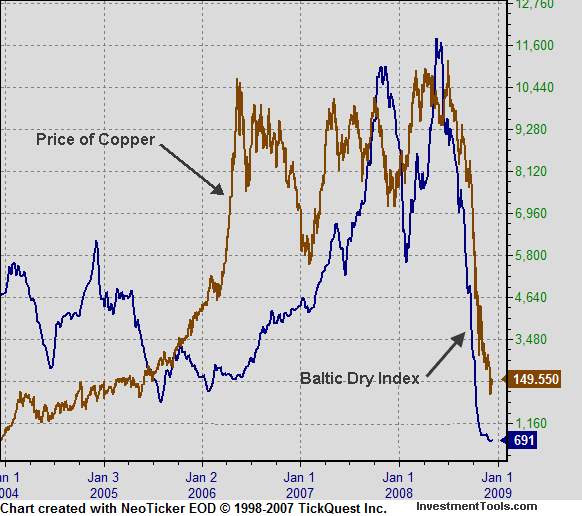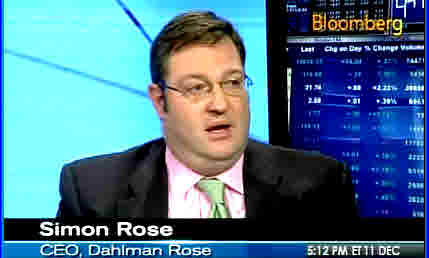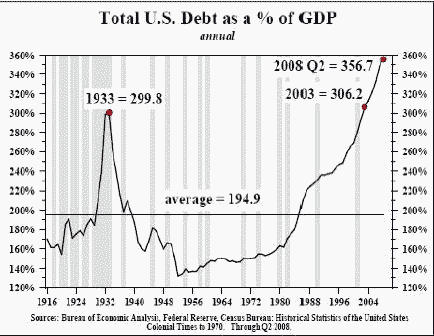
Dynamics

|
Generational Dynamics |
| Forecasting America's Destiny ... and the World's | |
| HOME WEB LOG COUNTRY WIKI COMMENT FORUM DOWNLOADS ABOUT | |
Chinese officials were shocked this week to learn that exports in November had fallen 10.4% from the previous month, and were down 2.2% from November of last year.
Even more dramatic, Chinese imports were down an astounding 18%.
These figures illuminate the rapid collapse of the Chinese economy. But more than that, they illuminate the rapid collapse of the entire worldwide trade and transportation mechanism.
Increasingly, for several years, the Chinese economy has been the epicenter of the world's transportation and trade, importing much of the world's mined copper, iron ore, lead and zinc. For example, until recently, China consumed a quarter of the world's copper. China would import parts and other intermediate goods from other Asian countries in the region, and would use all of these imported goods in their own factories, manufacturing finished products for export to America and Europe.
 |
To many people, the biggest shock of all is the 90% collapse of the Baltic Dry Index in the last six months or so, as shown on the adjacent chart.
The Baltic Dry Index is a measure of shipping costs for cargoes in "capesize" vessels -- vessels that are too large to fit through the Suez or Panama canals, and so must go around the Cape of Good Hope or Cape Horn. These vessels transport the huge cargoes of copper, iron ore and other commodities that China has been importing.
Most analysts realized that the BDI was in a bubble, and that the bubble would have to fall, but none of these analysts were expecting the fall of over 90%, from a high of around 11,700 to it's current value of 691.
Analysts had expected it to fall to its previous average, around the 3,000 to 4,000 level. But what we're seeing is the Law of Mean Reversion in action. Some people have written to me, questioning whether the Law of Mean Reversion is a "real law." The 90%+ collapse of the BDI is an example. Instead of falling to its previous average, the BDI has fallen well below, and will probably not return to its previous average for several years.
Incidentally, the chart above contains a secret. It shows how the price of copper has also collapsed, but only to its previous average. By the Law of Mean Reversion, the price of copper is going to fall much farther.
The chain reaction spreads far and wide. Rio Tinto, the second largest mining firm in the world, will cut 14,000 jobs. As one company after another tanks and lays people off, more companies are forced to do the same.
Last month, I quoted an interview with Simon Rose, CEO Dahlman-Rose, an expert on international shipping and trade.
 |
On Thursday, Rose appeared again on Bloomberg tv, bringing with him a photo of a Singapore golf course. Here's my transcription of most of the interview, in which he explains that the importance of the picture is not the golf course, but what's in the background:
There's an incredible amount of financial destruction and pain at every level of the supply chain, whether it's a mine worker whose digging a mineral out of the earth, or being laid off by Rio Tinto, which is a direct corollary. The trains that take it to the port. The ships that take it from the port to the smelter. The smelter workers. There's just an incredible amount of financial destruction right now, and no one could have foreseen that this global calamity in terms of credit availability would cause this.
There are two things to look at. There are letters of credit, which were a major problem the last time we spoke, a month ago, and they're starting to loosen up a little bit. You can more products slightly more readily.
But the larger issue is project finance -- big projects that require steel, require concrete. The financing just isn't there. The financing market is still frozen for these large projects. And until we see that start to loosen, these stimulus packages, the dollars being talked about have to be spent. ...
There's about $500 billion worth of new builds [of new ships] on order, $250 billion of capital roughly has been committed against those new builds. A lot of that capital is being taken off the table by banks, if they can -- they're just scrounging for the money themselves. The $250 [billion] that's not committed probably won't get committed.
 |
So it's a real mess right now, and the problem from a ship owner's perspective is, you thought you had a loan, a commitment from a bank, is it really a commitment, can they take delivery of a $150 million ship that might be worth a fraction of that today - does that stress the credit agreement that you have with the bank. It's just an absolute mess.
This is an industry that is in absolute chaos, and it's in chaos not because of anything that the ship owners or the mineral people or the steel mills could foresee. They were absolutely blindsided by this."
Companies around the world have been blindsided.
And the problems aren't just hurting Asia. The same things are happening to American domestic firms, as companies in industries ranging from trucking to railroads to ocean shipping are scaling back sharply. According to one analyst, 2008 "is going to be the worst year for transportation demand in 30 years."
Beyond the transportation industry, a variety of economic indicators are showing results that haven't been seen in decades.
Most people believe that interest rates can never go below zero. Why would you ever pay someone to let him loan you some money?
But negative interest rates became a reality last week in the sale of Treasury bills.
When the Treasury Dept. auctions off Treasury bills, investors can bid on them, essentially as a very safe investment. When the T-bills expire (say, after 3 or 6 months), the investors redeem them to get their money back, plus interest. The amount of money they get back is always the same, and so the interest rate (or "yield") depends on the price they initially paid for them. The higher the price at auction, the lower the yield.
In "normal" times, the yield is a little higher than the overnight Fed Funds rate, which is currently set at 1%.
On Tuesday, interest rates went negative. Specifically, the Treasury sold $27 billion of 3-month T-bills with a negative yield: -0.01%. $30 billion of 4-week T-bills were sold at 0% yield. This is the first time that this has happened since 1929.
This is a measure of the increasing "risk aversion" of investors. People (like CNBC anchors) who are fantasizing that someone in Washington will wave a magic wand and make the credit crisis disappear should understand what's going on. Investors are so unwilling to invest or lend money that they're actually paying the US Treasury to hold their money for them. It's like putting your money into a safe deposit box, where you get no interest but also pay for the box.
As I've said many times, what's important to Generational Dynamics is changes in attitude and behavior of large masses of people. In the past year, we've seen enormous changes in risk aversion among investors, going from a willingness to invest in the stupidest things to a reluctance to invest in anything that carries any risk at all.
That's why it's interesting, from the point of view of Generational Dynamics, that we're seeing more and more speculation of the the possibility of a default by the US Government.
 |
The reason for this increased concern is the exponential growth of public debt. I first posted an earlier version of the following graph in a 2004 article.
Here's an updated version of a graph that shows public debt as a percentage of GDP. (The vertical bars indicate times of recession.)
As you can see, public debt has been growing steadily since the early 1950s. But if you look closely, you'll see that public debt was beginning to level off in the early 1990s. But then, in 1995, it turned sharply upward, and has been increasing ever since.
Of course, 1995 was the beginning of the dot-com bubble, and it was also the point in time when the risk-averse survivors of the Great Depression all retired or died, leaving behind the Boomers to run things, and increase debt to uncontrolled levels. In the 2000s, the Gen-Xers joined in the fun, and now the public debt is streaking into the stratosphere, with no sign of stopping.
In the early days of this web site, I would get comments like the following: "How can you ever be wrong? If there's no stock market crash, then all you have to say is that it's still coming. You can never be wrong."
My response was: "I'll be happy to admit I was wrong when the exponential growth of balance of payments deficit and public debt begin to level off and start falling. Unless that happens, a stock market crash is coming with absolute certainty."
Now, many years later, the balance of payments deficit and public debt are still growing exponentially, with no sign of stopping, and no hope of stopping them.
A forum member has pointed out a a recent video interview of 80 year old former Goldman Sachs Chairman John Whitehead.
Whitehead lists a number of problems the country has, each of which will require multi-trillion dollars of expense: the social security and medicare bankruptcy, universal health insurance, infrastructure (all our bridges and roads were build 50+ years ago), energy independence, global warming, foreclosures, credit card defaults, etc.
Nobody's talking about cutting any of these programs or any expenses, which means that public debt will continue to grow exponentially, until something makes it stop.
Stein's Law: If something cannot go on forever, then it won't.
You can listen to the clowns in Washington, including President-elect Obama, and you won't hear a peep about cutting expenses to reduce the level of public debt. Just the opposite -- all they talk about is spending as much money as possible. (See "One, Two, Three ... Infinity.") I really have to laugh when I hear any of these clowns talk about this stuff.
In fact, my mind was totally boggled in one of the Sunday morning news shows when I heard one political pundit say -- and I'm not joking -- "This financial crisis presents a historic opportunity for Obama, because the ideological Republicans won't be able to stop him from spending money on a variety of new programs," referring to list of problems similar to Whitehead's above.
Can you believe this? This is what passes for "analysis" on these shows. These journalists, politicians and pundits are the stupidest bunch of clowns imaginable. And later, when the crisis comes, they'll all be saying, "Gawrsh -- nobody could have seen THAT coming."
Whitehead sees it coming. He was a teenager during the Great Depression, and in the video he concludes that the current financial crisis will be "a worse depression than the one in the 1930s." No kidding!"
As I'm writing this, there's a segment on CBS's 60 Minutes, with the title, "A Second Mortgage Disaster On The Horizon?"
Apparently the clever geniuses at CBS news have just discovered about adjustable rate mortgages (ARMs). These are mortgages that were approved at very low "teaser" interest rates, sometimes as low as 1%. The great mass of these ARMs are going to reset in 2009 and 2010, and a homeowner's $1000 a month mortgage will suddenly go to $4000 a month.
Well, I've writing about these mortgages for several years now, and so have a lot of bloggers.
When you listen to the 60 Minutes segment, you hear the anchor, Scott Pelley, use that gee-whiz tone of voice when he says stuff like, "Wow! I didn't know that was going to happen." Well, it's nice that the geniuses at CBS News finally caught on to what a lot of people were talking about years ago.
The title of this article is "World wide transportation and trade sink farther into deep freeze." I started this article by painting a picture of increasing destitution around the world, as factories and stores close, and people become jobless and homeless.
During the last two years, many people were speculating about a US recession, and there was a big debate at all the big economics conferences and among television economists about "decoupling." According to this theory, other countries' economies had "decoupled" from America's economy, so that a US recession would have no noticeable effect on other economies.
This is one of those ideas that only a complete moron (or a mainstream economist) could possibly believe, or even consider.
What's actually happened is that America and China, two civilizations that have always been almost completely foreign to one another, are now locked together, arm in arm, in a death spiral downward that will leave both countries, and all of their neighbors, economically devastated.
From the point of view of Generational Dynamics, there is still one more "shoe to drop" -- a massive, worldwide generational panic and crash. I've described many times what I expect to see happen; here's a summary: An elemental force of nature, where millions or even tens of millions of Boomers and Generation-Xers in countries around the world, never having seen anything like this before, and not having believed it was even possible, suddenly try to sell everything in a mass panic. This will bring down computer systems for hours, perhaps even for a day or two, as people watch tv in glazed horror as their life savings disappear.
I sometimes laugh when I hear a Generation-Xer complain about how much his life sucks, or how miserable it's been. Most Xers have never had a tough day in their lives, or worked a hard day in their lives. They have no idea how easy their lives have been.
All of that is about to change. With transportation and trade going into a deep freeze around the world, the earth is grinding to a halt.
And from the point of view of Generational Dynamics, once the earth has ground to a halt, only one thing can get it moving again: A massive world war, a Clash of Civilizations, the greatest war in history.
(Comments: For reader comments, questions and discussion, as
well as more frequent updates on this subject, see the Financial Topics thread of the Generational Dynamics forum. Read
the entire thread for discussions on how to protect your money.)
(15-Dec-2008)
Permanent Link
Receive daily World View columns by e-mail
Donate to Generational Dynamics via PayPal
Web Log Summary - 2016
Web Log Summary - 2015
Web Log Summary - 2014
Web Log Summary - 2013
Web Log Summary - 2012
Web Log Summary - 2011
Web Log Summary - 2010
Web Log Summary - 2009
Web Log Summary - 2008
Web Log Summary - 2007
Web Log Summary - 2006
Web Log Summary - 2005
Web Log Summary - 2004
Web Log - December, 2016
Web Log - November, 2016
Web Log - October, 2016
Web Log - September, 2016
Web Log - August, 2016
Web Log - July, 2016
Web Log - June, 2016
Web Log - May, 2016
Web Log - April, 2016
Web Log - March, 2016
Web Log - February, 2016
Web Log - January, 2016
Web Log - December, 2015
Web Log - November, 2015
Web Log - October, 2015
Web Log - September, 2015
Web Log - August, 2015
Web Log - July, 2015
Web Log - June, 2015
Web Log - May, 2015
Web Log - April, 2015
Web Log - March, 2015
Web Log - February, 2015
Web Log - January, 2015
Web Log - December, 2014
Web Log - November, 2014
Web Log - October, 2014
Web Log - September, 2014
Web Log - August, 2014
Web Log - July, 2014
Web Log - June, 2014
Web Log - May, 2014
Web Log - April, 2014
Web Log - March, 2014
Web Log - February, 2014
Web Log - January, 2014
Web Log - December, 2013
Web Log - November, 2013
Web Log - October, 2013
Web Log - September, 2013
Web Log - August, 2013
Web Log - July, 2013
Web Log - June, 2013
Web Log - May, 2013
Web Log - April, 2013
Web Log - March, 2013
Web Log - February, 2013
Web Log - January, 2013
Web Log - December, 2012
Web Log - November, 2012
Web Log - October, 2012
Web Log - September, 2012
Web Log - August, 2012
Web Log - July, 2012
Web Log - June, 2012
Web Log - May, 2012
Web Log - April, 2012
Web Log - March, 2012
Web Log - February, 2012
Web Log - January, 2012
Web Log - December, 2011
Web Log - November, 2011
Web Log - October, 2011
Web Log - September, 2011
Web Log - August, 2011
Web Log - July, 2011
Web Log - June, 2011
Web Log - May, 2011
Web Log - April, 2011
Web Log - March, 2011
Web Log - February, 2011
Web Log - January, 2011
Web Log - December, 2010
Web Log - November, 2010
Web Log - October, 2010
Web Log - September, 2010
Web Log - August, 2010
Web Log - July, 2010
Web Log - June, 2010
Web Log - May, 2010
Web Log - April, 2010
Web Log - March, 2010
Web Log - February, 2010
Web Log - January, 2010
Web Log - December, 2009
Web Log - November, 2009
Web Log - October, 2009
Web Log - September, 2009
Web Log - August, 2009
Web Log - July, 2009
Web Log - June, 2009
Web Log - May, 2009
Web Log - April, 2009
Web Log - March, 2009
Web Log - February, 2009
Web Log - January, 2009
Web Log - December, 2008
Web Log - November, 2008
Web Log - October, 2008
Web Log - September, 2008
Web Log - August, 2008
Web Log - July, 2008
Web Log - June, 2008
Web Log - May, 2008
Web Log - April, 2008
Web Log - March, 2008
Web Log - February, 2008
Web Log - January, 2008
Web Log - December, 2007
Web Log - November, 2007
Web Log - October, 2007
Web Log - September, 2007
Web Log - August, 2007
Web Log - July, 2007
Web Log - June, 2007
Web Log - May, 2007
Web Log - April, 2007
Web Log - March, 2007
Web Log - February, 2007
Web Log - January, 2007
Web Log - December, 2006
Web Log - November, 2006
Web Log - October, 2006
Web Log - September, 2006
Web Log - August, 2006
Web Log - July, 2006
Web Log - June, 2006
Web Log - May, 2006
Web Log - April, 2006
Web Log - March, 2006
Web Log - February, 2006
Web Log - January, 2006
Web Log - December, 2005
Web Log - November, 2005
Web Log - October, 2005
Web Log - September, 2005
Web Log - August, 2005
Web Log - July, 2005
Web Log - June, 2005
Web Log - May, 2005
Web Log - April, 2005
Web Log - March, 2005
Web Log - February, 2005
Web Log - January, 2005
Web Log - December, 2004
Web Log - November, 2004
Web Log - October, 2004
Web Log - September, 2004
Web Log - August, 2004
Web Log - July, 2004
Web Log - June, 2004